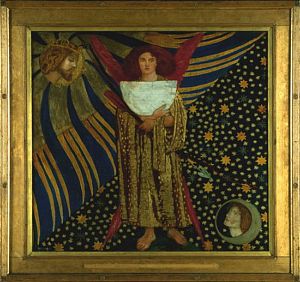Dantis Amor 1860
Description: The central figure in this picture is Love, who is holding what would have been a sundial (if the picture had been completed). He stands against a decorative background divided along a diagonal running from upper right to lower left. In the upper left quadrant is the head of Christ, figured as the sun, looking down across a heavily stylized field of sun rays that emanate from the circle surrounding his head. His gaze is directed toward the figure of Beatrice, whose face is inscribed in a crescent moon in the lower right quadrant against a background of stars.
This picture, which was not completed, was to have been the central panel of three for a cabinet at William Morris's Red House, Bexley Heath. The cabinet is still there, but some time before August 1863, the two finished panels were removed and made into a diptych with a narrow central separator where a schematic form of the figure of Love (as depicted in this work) appears. This two-panel work is The Salutation of Beatrice,
Описание: центральной фигурой на этой картине является Любовь, держащая то, что будь картина закончена, стало бы циферблатом солнечных часов. Он (любовь в английском мужского рода) стоит на декоративном фоне, разделённом по диагонали справа налево. В левом верхнем квадранте изображена голова Христа в виде Солнца, голова смотрит через стилизованные лучи, исходящие из окружающего её круга. Его взгляд направлен на Беатриче, чьё лицо помещено в серп месяца и расположено в нижнем правом квадранте на фоне звёзд. Эта картина, которая не была завершена, должна была стать центральной панелью триптиха для кабинета Красного дома Вильяма Морриса. Кабинет и сейчас тут, но перед августом 1863 года две законченные панели были превращены в диптих с разделяющей панели схематически изображенной фигурой Любви. Это диптих The Salutation of Beatrice.

The picture is a symbolistic representation of the death of Beatrice and the meaning of that death. As the central panel of the projected triptych, that death stood between the two salutations given to Dante by Beatrice, the one in the Vita Nuova (see chapter III), the other in the Purgatorio Canto XXX. Grieve says that the picture, “represents the essential truth of both the Vita Nuova and the Divina Commedia, that Love is the generating force of the universe” (see Tate 1984, 179). In his left hand the figure of Love holds a bow and arrow, in his right an (unfinished) sundial; the latter would have pointed to the ninth hour, the hour of Christ's and of Beatrice's death alike. The time is represented in the versions of this picture that are complete. Ainsworth says that the picture specifically illustrates the Vita Nuova, chapter XXVIII, “when the Lord God of justice called my most gracious lady unto Himself”
Dantis Amor 1860 (circa)
This unfinished work was intended to be the center panel of the cabinet at Red House from which The Salutation of Beatrice was later removed.

This picture is the finished design for the oil painting, but its details are more elaborated.
Included Text
The three inscriptions are all from Dante: the first two come from the concluding sentence of the Vita Nuova; the third from the last line of the Paradiso.
Annie Miller 1860

Annie miller 1860
Этот рисунок напоминает по стилю серию портретов, начатых Россетти в 1858 году (Jane Morris, ruth Herbert, Fanny Cornforth).
Портреты воспевают женскую красоту (в понимании прерафаэлитов), подчёркивается длина шеи, чёткий профиль, "губы Купидона", тяжелые веки, обилие вьющихся волос. На Миллер хотел жениться Хант и только после того, как помолвка была расторгнута в 1859 году она снова поступила в пользование всех прерафаэлитов в качестве модели.
